ウナギはどこで生まれるか、ご存じですか?
ウナギは日本の沿岸から何千キロも離れた海で卵を産み、命を終えます。
孵化した稚魚は長い旅を経て、日本の淡水域へと戻ってきます。
SPAC-静岡県舞台芸術センターの新たなプロジェクトでは、劇作家・石神夏希さんのもと、SPACの俳優と静岡に住むブラジルにルーツを持つ出演者たちが、この不思議な魚の旅をモチーフに演劇を通じて新たな物語を紡いでいます。
〜演劇は、自分が生まれるよりもずっと前に始まった物語を引き継ぐ、唯一の方法だ〜
◼️唯一のインスピレーションは「想像力」
稽古初日から、私はこのプロジェクトにおける音楽の重要性を実感していました。演出家・石神夏希さんと出演者たちは、わずか数日で「うなぎの回遊」プロジェクトの本質を提示しなければなりません。そのために頼りにしているのが、生演奏です。
音楽制作を担うのはSPACで数多くの作曲を手がけてきた舞台音楽家・棚川寛子さん。石神さんとは初めてのコラボレーションですが、今までのSPACでの創作と同様、棚川さんの音楽は一人で創るものではありません。長年の仲間たちと共に、即興的にその場でメロディーを紡いでいきます。俳優たちは楽器を手に取り、棚川さんの指示に従ったり、意見を出し合ったりしながら、うなぎの旅路の「音」を探っていきます。
「SPACの作品では、いつもこうやって音楽をつくってきました」と棚川さんは言います。SPAC芸術総監督・宮城聰さんとの長年の創作を通じて培われた、集団創作のスタイルに彼女は「音楽とは、人と人のつながりをつくるものです」と語ります。舞台上では言葉による会話はできず、台本を見ることもできない。そのような状況で必要なのは、互いの気配を音で感じ合える関係性です。
「舞台上でどんな空気をつくるのか、全員がそのイメージを正確に持つことがとても重要なんです」
彼女の直感からはじまる音の創作。音楽学校などで学ぶような方法とは一線を画し、独学で打楽器を学んできた彼女が、譜面を一切使わずに音の世界を描いていく。そんなSPACが誇る舞台音楽家の姿に、私は目を奪われました。稽古場は次第に、深海へと詩的に潜っていく空間へと変わっていきます。
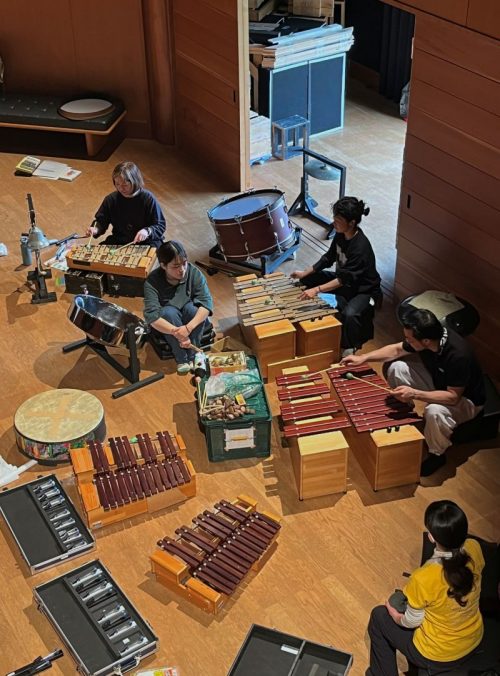
オープン・スタジオのための音楽を製作する俳優・スタッフ
◼️深海を音で表現するには?
ある日棚川さんはホワイトボードに海面の線と、上昇する渦のような螺旋を描きました。これは、生まれたばかりのうなぎがマリアナ海域の中層から浮上し、海面を目指す旅の道筋。この旅は、潮の流れに導かれ、月明かりが海面を照らす中で進むこともある、時に危険な道のりです。
では、この旅をどうやって音にすればよいのでしょう?
生命がはじまる瞬間の感覚を、遠く離れた人間がどう想像すればよいのでしょう?
人の耳にも、うなぎの耳にも届かないはずの深海の「誕生」を、どう音にできるのでしょう?
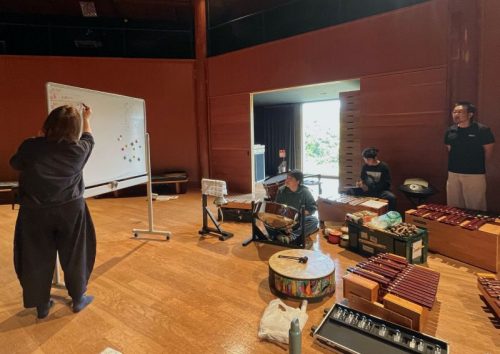
メロディーのイメージを共有するためにホワイトボードを使う棚川さん
その日、稽古場に並んださまざまな打楽器――バスドラム、木琴、音叉、ベル、チベタンボウル――そのどれもが、うなぎの旅路を描くために使われます。バスドラムの低音は海底の振動、シンギングボウルは水面のホワイトノイズを表現。言葉は一切使われず、この旅路はすべて音によって語られるのです。
このホワイトボードに描かれた螺旋は、音楽構成の核にもなります。三拍子のリズムが円環を描き、「生から死へ、死から生へ」「出発から帰還へ、帰還からまた新たな出発へ」という、循環する命の営みを私たちに想起させます。録音された声が生み出す効果も、うなぎが渦を巻いて浮かび上がる感覚を高め、観客の周囲を取り囲むような音世界を創り出していました。ひとつひとつの音が、「私はここに生まれた」と名乗るように響き渡り、私たちはその誕生を見守るのです。数日間の稽古とは思えない完成度に、私は心から感動していました。
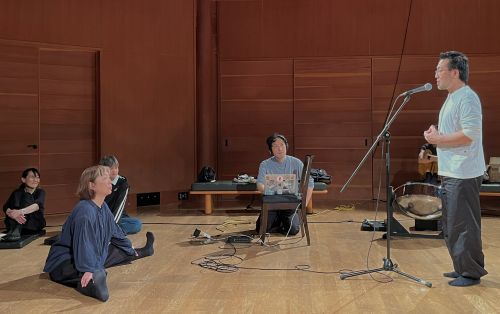
円環する音楽の一部として吹き込まれる出演者の声
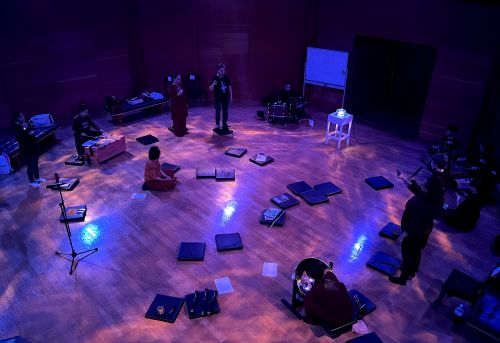
海の深みを描き出す照明と音楽
◼️D♯4のトーンチャイムを鳴らす女神になるまで
インターン参加初日、稽古場で何が話されているのかまだよくわからないままにいた私に、棚川さんはD♯4(レ♯)と書かれたトーンチャイムを手渡してくれました。見たこともない楽器に戸惑いつつ、なんとなく周囲の真似をして振ってみたら、音が出た。その瞬間、私は「見学者」ではなくなっていました。
棚川さんの「音楽は言葉を超えて人と人をつなぐもの」という話に深く共感し、断る理由など見つかりませんでした。とはいえ、私はクラリネットを長年吹いていたとはいえ、打楽器の経験はゼロ。しかし棚川さんの方法は、技術よりも想像力が鍵なのです。「この楽器を、海に声を響かせる女神のように扱って」と彼女は言いました。気後れしつつも私はその役割を引き受け、オープンスタジオの終わりまで、D♯4の女神になる!と決めました。
こうして、私もSPACの制作チームの一員として、俳優たちやブラジルにルーツを持つ県民出演者とともに、この音楽セッションに参加することになりました。円を描いて並ぶ出演者たちの周りには、日本語、ブラジル・ポルトガル語、英語、そしてときどきフランス語も飛び交います。でも、ひとたび演奏が始まれば、そこにあるのはただひとつの声――音楽の声です。
最初は小節を数えるのに必死だった私も、やがて音の流れに身をゆだね、皆とひとつの旋律をつくっているという実感を味わいました。それは、美しく、鮮やかで、没入感があり、心の底から満たされる体験でした。これまで見た中で、最も効果的な非言語で行われるチームワークの構築だったと言えるかもしれません。
◼️自己紹介
私の名前はエレーヌ。フランスで5年ほどフランス国立の劇場でのスタッフとして経験を積んだ後、「自分を自由にする」ため、日本へやってきました。ご縁あってSPACの皆さんに迎えていただき、石神夏希演出による『うなぎプロジェクト』のオープンスタジオ準備に数週間、同行する機会をいただきました。
ENGLISH
FOLLOWING UP “EEL MIGRATION”
~Part II : Musically diving into the deep ocean~
Have you ever wondered where eels are born?
Eels lay their eggs thousands of miles from the Japanese coast, and die once it pours out its seed.
Once the baby eel is out of its shell, it travels back to Japan to live in the country’s fresh waters.
In this new project by the Shizuoka Performing Arts Center, director Natsuki Ishigami brings together actors from SPAC and non-professional actors with roots in Brazil who live in Shizuoka prefecture, with the concept inspired by journey of these fascinating 100-million-year-old fish.
“Theatre is the only way to take up a story that someone else started long before I was born.”
◼️The only inspiration is the imagination
From the very beginning of the rehearsals, I realised the importance of music in this project. In just a few days, director Natsuki Ishigami and her performers must present the quintessence of what the Eel Migration project will be, and they intend to rely on live music to do so. It is the SPAC composer, Hiroko Tanakawa, who is entrusted with the creation of the music on stage for her first collaboration with Natsuki Ishigami – but as always at SPAC, she does not work alone. Surrounded by her long-time colleagues, she counts on their musical talents to create the melody together, in situ. The actors and actresses pick up instruments, follow her instructions, commenting and making suggestions to try to capture the sound of the eels’ migration.
“That’s how I’ve always composed the music for the shows created here,” Hiroko Tanakawa tells me. Having worked with the venue’s director, Satoshi Miyagi, for several decades now, the composer is familiar with this method of collective work – and she cannot imagine working any other way or anywhere else. “Making music is about creating connections between people,” she explains to me. According to her, music allows the people on stage to communicate with each other without dialogue, because during a performance it’s impossible to talk or rely on written instructions, so everyone must be immersed in the world of the piece. “It’s very important that everyone has a precise idea of the atmosphere that will be created on stage,” she concludes.
This collective creation that unfolds before my eyes, she imagines the melody starting from her intuition. Far from music schools, the musical creator of SPAC taught herself the percussion she now uses to write her imaginary scores, never once writing a single line on sheet music. I am fascinated by this creativity in action and by the way the rehearsal room gradually transforms before my eyes into a poetic dive into the heart of the ocean.

Actors and music composer writing live the music of the Open Studio.
◼️How do you musically recreate the depths of the ocean ?
In front of her attentive collaborators, the composer takes a marker and draws a line on a whiteboard – the sea level – and an ascending spiral. This whirlpool represents the path taken by newborn eels as they rise to the surface, thus leaving the intermediate waters of the Mariana Seas. It is a journey rhythmically guided by the ocean currents, sometimes dangerous, illuminated by the moonlight piercing the surface of the water. But how to musically transcribe this journey ? How can one imagine what a living being feels when it enters existence, so far from home ? How to set to music a birth in the heart of the ocean, where neither men nor eels can hear the slightest sound ?

The music composer is using the white board to help everyone visualize the music.
This dreamlike epic, the SPAC team will reproduce it thanks to the diversity of percussion instruments, numerous in the rehearsal room that day: bass drums, xylophones, tone chimes, bells, Tibetan bowls, all the sounds are available to recreate this millennial ascent. The deep sounds of the bass drum to convey the numerous vibrations of the ocean floor, the singing bowls to reproduce the white noise of the water’s surface, each instrument contributes to building the narrative. No text is then spoken by any performer at this stage of the workshops, this entire journey is transcribed by the imaginative power of music.
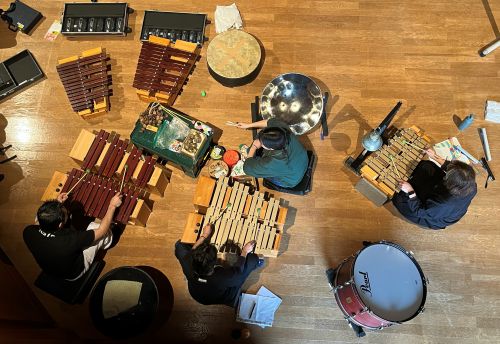
All kinds of percussion instruments are available on set for creation.
The circularity of this spiral drawn on a whiteboard becomes the very core of the musical composition. Carried away by a ternary rhythm that creates circularity, the melody plunges us into the cyclical nature of existence: the cycle from birth to death, from death to birth, from a departure that leads to a return, from a return that also becomes a new departure. The loop effects present in the sound arrangement reinforce this spiral feeling, creating around the spectator the impression of being surrounded by eels rising to the surface. Each one is there, around us, pronouncing its name as if to symbolically affirm its birth, and we accompany them in their coming to life. In just a few days of rehearsal, I am amazed by the result. And completely won over. During a quick break, I take a quick glance at my notebook and notice a sentence that the director Natsuki Ishigami said earlier in the week : “The power of creation”. I think it is the best way to put it.

The recording of the voice in order to create the looping effect.

Visualizing the depths of the ocean.
◼️How I end up playing the tonechime
From the very first day, while I try to understand what was being said in Japanese, Hiroko Tanakawa enthusiastically hands me a tone chime with D♯4 written on it. Having never seen this instrument in my life, I am intrigued but out of mimicry, I shake it, a note comes out, thus ending my role as a mere observer. After listening to the composer speak about how music made people communicate beyond words, I was so agreeing with her that I could not say no. However, there remains a slight problem – even though I studied music theory and played clarinet for years, I am not a percussionist. Fortunately, the composer’s method is based more on imagination than on technique : “Handle this instrument as if you were a goddess spreading her voice throughout the ocean,” she tells me. Imposter syndrome aside, I let myself be tempted by the exercise and dedicated that until the end of the Open Studio, I will be the goddess of the D♯4 tone chime.
And that’s how the members of the SPAC production team and I joined the professional actors and non-professional actors with roots in Brazil who live in Shizuoka prefecture to collaborate together on the realisation of this live musical session of the Open Studio. Around the circle formed by the performers, it is always possible to hear Japanese, Brazilian Portuguese, English, even French, but when we play, there is only one voice in unison: the one of music. Initially focused on counting the measures, I eventually let go and opened myself to the melody we all formed together : it’s beautiful, vivid, immersive, and so satisfying. I believe that this musical workshop was the most effective non-verbal team-building exercise I have ever seen in my life.
◼️Who am I?
My name is Hélène, and after almost five years of experiences in theatre and national stages in France, I’ve come to Japan to lose – or find – myself. Welcomed by the SPAC teams for a few weeks,, I had the chance to follow the setting up of the Open Studio of the Eel Project, a SPAC creation scheduled for Spring 2026, directed by Natsuki Ishigami.
FRENCH
SUR LA ROUTE DU EEL MIGRATION, Partie 2 : Plonger dans l’univers sonore du fond des océans
Vous êtes-vous déjà demandés où naissent les anguilles ?
Les anguilles pondent à des milliers de kilomètres des côtes japonaises, et décèdent une fois qu’elles ont frayé. Leurs petits, une fois sortis de leur coquille, font le trajet inverse pour revenir vivre dans les eaux du Japon.
Dans ce nouveau projet du Shizuoka Performing Arts Center, la metteur en scène Natsuki Ishigami réunit comédiens du SPAC et comédiens non-professionnels, ayant une attache avec le Brésil et vivant dans la préfecture de Shizuoka, dans un projet inspiré par le fascinant voyage de ces poissons symboliques, vieux de 100 millions d’années.
“Le Théâtre est la seule manière de reprendre une histoire que quelqu’un d’autre a commencée bien avant ma naissance”
L’inspiration vient de l’imagination
Dès le début des répétitions, je comprends l’importance que tient la musique dans ce projet. En à peine quelques jours, la metteur en scène Natsuki Ishigami et ses neufs interprètes doivent présenter la quintessence de ce que sera le projet Eel Migration et comptent bien s’appuyer sur la musique live pour y parvenir. C’est à la compositrice du SPAC, Hiroko Tanakawa qu’est confiée pour sa première collaboration avec Natsuki Ishigami la réalisation de la musique au plateau – mais comme toujours au SPAC, elle ne travaille pas seule. Entourée de ses collègues de longue date, elle compte sur leurs talents musicaux pour créer ensemble, in situ, la mélodie. Comédien, comédienne, chacun se saisit d’un instrument et suit ses directives, commente, fait des propositions pour tenter de mettre en son la migration des anguilles.
“C’est comme ça que j’ai toujours composé les musiques des spectacles qui se sont créés ici”, me raconte Hiroko Tanakawa. Travaillant avec le directeur du lieu, Satoshi Miyagi, depuis plusieurs dizaines d’années, la compositrice est familière de cette méthode de travail collective – et elle ne s’imagine pas travailler autrement ni ailleurs. “Faire de la musique, c’est créer du lien entre les gens”, m’explique t-elle. Selon elle, la musique permet aux personnes au plateau de communiquer entre elles sans dialoguer, car en pleine performance impossible de parler, ni de se fier aux instructions écrites, il faut donc que chacun soit immergé dans l’univers de la pièce. “C’est très important que tout le monde ait une idée précise de l’ambiance qui va se créer sur scène”, conclut-elle.
Cette création collective qui s’invente sous mes yeux, elle en imagine la mélodie en partant de son intuition. Loin des écoles de musique, la créatrice musicale du SPAC a appris par elle-même les percussions dont elle se sert aujourd’hui pour écrire ses partitions imaginaires, sans jamais noter la moindre ligne sur du papier à musique. Je suis fascinée par cette créativité en action et par la manière dont progressivement, la salle de répétition se transforme sous mes yeux en plongée poétique au cœur de l’océan.

La compositrice et les comédiens en pleine écriture de la musique de l’Open Studio.
Comment mettre en musique le fond de l’océan ?

La compositrice utilisant le tableau blanc pour aider à la visualisation de la mélodie.
Devant ses collaborateurs attentifs, la compositrice musicale s’arme d’un feutre et dessine sur un tableau blanc un trait – le niveau de la mer – et une spirale ascendante. Ce tourbillon représente le chemin emprunté par les anguilles naissantes lorsqu’elles remontent vers la surface, quittant ainsi les eaux intermédiaires des mers Mariannes. C’est un voyage rythmé par les courants marins, parfois dangereux, guidé par les lueurs de la lune qui percent à la surface de l’eau. Mais comment retranscrire musicalement ce périple ? Comment s’imaginer ce que ressent un être vivant qui entre dans l’existence, si loin de chez lui ? Comment mettre en musique une naissance au cœur de l’océan, là où ni hommes ni anguilles ne peuvent entendre le moindre son ?
Cette épopée onirique, l’équipe du SPAC va la reproduire grâce à la diversité des percussions, nombreuses dans la salle de répétition ce jour là : grosses caisses, xylophones, tones chimes, cloches, bols tibétain, toutes les sonorités sont à disposition pour recréer cette ascension millénaire. Les sons profonds de la grosse caisse pour retranscrire les nombreuses vibrations du fond de l’océan, les bols tibétains pour reproduire le bruit blanc de l’eau en surface, ce sont chaque instrument qui participe à construire la narration. Aucun texte n’est alors prononcé par le moindre interprète à ce stade, tout ce périple est retranscrit par le pouvoir créatif de la musique.

La multitude de percussions présentes au plateau.
La circularité de cette spirale dessinée sur tableau blanc devient la colonne vertébrale de la composition musicale. Emportée par un rythme ternaire qui crée la circularité, la mélodie nous plonge dans la nature cyclique de l’existence : le cycle de la naissance à la mort, de la mort à la naissance, d’un départ qui mène à un retour, d’un retour qui se fait lui aussi un nouveau départ. Les effets de loop présents dans l’arrangement sonore renforcent ce sentiment de spirale qui crée autour du spectateur l’impression d’être entouré d’anguilles remontant à la surface. Chacune est là, autour de nous, prononçant son nom comme pour affirmer symboliquement sa naissance, et nous les accompagnons dans leur venue au monde. En quelques jours de répétition, je suis épatée du résultat. Et conquise. Je jette un regard rapide sur mon carnet de notes et butte sur une phrase prononcée par la metteur en scène Natsuki Ishigami plus tôt dans la semaine : “Le pouvoir de la création”. Je n’aurais pas dit mieux.

L’enregistrement des pistes sons pour créer les effets de looping.

Recréer le fond des océans.
Percussionniste le temps du projet
Dès le premier jour, tandis que je tente de comprendre ce qu’il se dit, Hiroko Tanakawa me tend en souriant une tone chime où il est écrit D♯4. N’ayant jamais vu cet instrument de ma vie, je suis intriguée, mais par mimétisme, je secoue, une note sort, sonnant ainsi le glas de mon rôle de simple observatrice. Après avoir écouté la compositrice parler avec enthousiasme de la manière dont la musique faisait communiquer les gens au-delà des mots, je ne pouvais qu’accepter de participer au projet. Cependant, reste un problème de taille : j’ai beau avoir étudié le solfège et joué de la clarinette pendant des années, je ne suis pas percussionniste. Heureusement, la méthode de la compositrice se base sur l’imagination plus que sur la technique : “Manie cet instrument comme si tu étais une déesse qui répand sa voix dans tout l’océan”, me dit-elle. Syndrome de l’imposteur mis à part, je me laisse tenter par l’exercice : je serai jusqu’à la fin de l’Open Studio, la déesse du tone chime D♯4.
Et c’est ainsi que les membres de l’équipe de production du SPAC et moi-même avons rejoint les comédiens professionnels et les participants de la communauté brésilienne d’Hamamatsu pour collaborer ensemble à la réalisation de cette live session musicale de l’Open Studio. Autour du cercle formé par les interprètes, il est toujours possible d’entendre du japonais, du portuguais brésilien, de l’anglais, du français même mais lorsque l’on joue, il n’y a plus qu’une seule voix à l’unisson : celle de la musique. Initialement concentrée sur le comptage des mesures, je finis par lâcher prise et m’ouvrir à la mélodie que nous formons tous ensemble : c’est beau, c’est imagé, immersif. Je crois bien que ce workshop musical était l’exercice de team building sans paroles le plus efficace que je n’ai jamais vu de ma vie.
Qui suis-je ?
Je m’appelle Hélène, et après presque cinq ans d’expériences en théâtre et scènes nationales en France, je suis venue me perdre au Japon. Recueillie par les équipes du SPAC pendant deux semaines, j’ai eu la chance de suivre la mise en place de l’Open Studio de l’Unagi Project, nouvelle production du SPAC prévue au Printemps 2026, dirigée par Natsuki Ishigami.